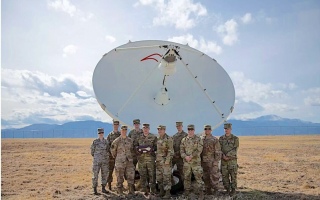Satellite Jammers Disrupt Russian or Chinese Communications
The US Space Force will install 24 satellite jammers capable of disrupting Russian or Chinese communications
July 23, 2024
War. War never changes: thanks to the military-industrial complex, the technology of war will continue to escalate no matter how the world situation changes. Russia is reportedly developing a high-altitude nuclear device that uses electromagnetic pulses to permanently and indiscriminately disrupt enemy communications. Meanwhile, the United States has just announced a weapon with similar purposes but without the chaotic and irreversible consequences.
The US military is installing modular advanced satellite signal jammer capable of disrupting Russian or Chinese communications if necessary. Although the hardware is terrestrial, the US Space Force will oversee the installation and operation. The technology has already completed prototyping. Earlier this year, the military tested the system at two different locations. The Department of Defense has allocated funds to build 24 remote facilities, 11 of which are scheduled to be deployed by the end of the year.
This equipment is not a preventive measure to prevent adversaries from disrupting US communications. Quite the opposite.
"[The terminals] are small, mobile, and low-cost SATCOM portable jammers that can be deployed in austere environments to protect [U.S. forces]," a spokesperson for the U.S. Space Force's Rapid Capabilities Office told Bloomberg. "[The jammer gps will be used] to responsibly counter an adversary's SATCOM capabilities to launch an attack."
"We intentionally designed a small, modular system using commercial off-the-shelf components. This provides the ability to be proliferated, remotely controlled, and relatively relocatable," the Space Force said.
Why it matters:
Other things to know:
July 23, 2024
War. War never changes: thanks to the military-industrial complex, the technology of war will continue to escalate no matter how the world situation changes. Russia is reportedly developing a high-altitude nuclear device that uses electromagnetic pulses to permanently and indiscriminately disrupt enemy communications. Meanwhile, the United States has just announced a weapon with similar purposes but without the chaotic and irreversible consequences.
The US military is installing modular advanced satellite signal jammer capable of disrupting Russian or Chinese communications if necessary. Although the hardware is terrestrial, the US Space Force will oversee the installation and operation. The technology has already completed prototyping. Earlier this year, the military tested the system at two different locations. The Department of Defense has allocated funds to build 24 remote facilities, 11 of which are scheduled to be deployed by the end of the year.
This equipment is not a preventive measure to prevent adversaries from disrupting US communications. Quite the opposite.
"[The terminals] are small, mobile, and low-cost SATCOM portable jammers that can be deployed in austere environments to protect [U.S. forces]," a spokesperson for the U.S. Space Force's Rapid Capabilities Office told Bloomberg. "[The jammer gps will be used] to responsibly counter an adversary's SATCOM capabilities to launch an attack."
"We intentionally designed a small, modular system using commercial off-the-shelf components. This provides the ability to be proliferated, remotely controlled, and relatively relocatable," the Space Force said.
Why it matters:
- This proves once again that when it comes to electronic warfare involving space assets, no signal is secure.
- This makes it pretty clear to you that at least China and Russia, and possibly Iran and North Korea, as well as other nations (and some of our allies) have similar capabilities.
- It should reinforce the idea that if a service is really that important (like PNT), we should have multiple widely available ways to get it, not just through space.
Other things to know:
- Both China and Russia have widely available non-space PNT methods.

コメントを書く...
Comments